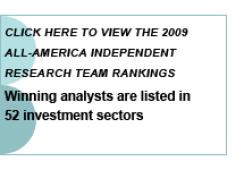Tough times don’t last, but tough analysts do. Take James Furey, for instance, who became unemployed in the spring of 2008 when New York–based money management firm Neuberger Berman jettisoned its small-cap research team. “We were out of a job — Neuberger Berman was no longer in a position to fund us,” he explains.
The Newport Beach, California–based researcher decided to launch his own shop. He teamed up with two analysts and two salespeople and launched Furey Research Partners on October 8, 2008, just weeks after Neuberger parent Lehman Brothers Holdings declared bankruptcy, sending financial markets into a tailspin.

The ranking, which considers researchers at outfits that do not engage in investment banking, is based on responses from portfolio managers and analysts at hundreds of asset management firms and hedge funds that participated in the 2009 All-America Research Team (see "A Time to Rebuild"). Voting was sufficient to publish results in 52 of the broader survey’s 65 industry sectors and macro disciplines. The table below and on page 78 lists the first-place analysts in each sector; more-detailed data can be found on our Web site, iimagazine.com.
Money managers say Sanford C. Bernstein & Co. is the undisputed champion of independent research; 27 of the New York–based firm ’s 30 publishing analysts are ranked — including five who rank in more than one sector — for a total of 33 team positions. Bernstein is home to more than half of the analysts in first place (29 of 52).
David Barnard, Bernstein’s director of U.S. research, says turmoil at bulge-bracket firms has helped spur demand for independent analysis — and not just in the U.S. Bernstein launched operations in Hong Kong in the second quarter, and Barnard says he plans to hire at least four publishing analysts for that office in the next six months, with the eventual goal of building an Asia ex-Japan team of ten to 12 analysts.
“A global perspective is something that clients are demanding more than ever before,” Barnard says, adding that Bernstein also has 15 analysts in its London office, and he expects that figure “to grow as well over the next couple of years.”
Anagha Gupte is one of the many Bernstein analysts to finish in first place. She began covering the Managed Care sector in October 2008 and impressed investors right off the bat with an outperform recommendation the following month on Philadelphia-based Cigna Corp., whose share price had plummeted to $10.39 — the stock had been trading above $40 a share just two months earlier — on concerns about its balance sheet. Gupte told investors that concerns were overstated because the risk to operating earnings from portfolio losses had already been priced into the stock. By late November 2009, Cigna’s shares had rebounded by an incredible 208.8 percent, to $32.08. During the same period the sector gained just 27.1 percent.
Gupte made another winning call in March when she upgraded UnitedHealth Group from market perform to outperform on the belief that the Minnetonka, Minnesota–based company’s “operational turnaround was bearing fruit.” The stock vaulted from $20.68 to $28.67 through November, a gain of 38.6 percent that bested the sector by 13 percentage points.
Gupte’s colleague Janet Brashear, No. 1 in Gaming & Lodging, is no stranger to winning stock picks, either. Brashear launched coverage of the sector in February and also hit a home run in her first time at bat. The analyst issued an outperform rating on Las Vegas Sands Corp. in mid-March, when “most analysts had written it off,” she says, because she believes the hotel and casino operator “has options to escape its liquidity bind and emerge with a stellar portfolio,” including “trophy assets in Asia” such as its properties in Macau and casino in Singapore. The stock, priced at a paltry $1.77 when Brashear made her recommendation, had skyrocketed an eye-popping 765.5 percent, to $15.32, by November 30. During the same period the sector rose 47.3 percent.
Second-place ISI Group, with 11 total team positions (including eight analysts in first place), also has found opportunities in the midst of the crisis. The New York–based firm has been expanding its research operations. Recent hires include David Raso, formerly of Citigroup (No. 1 in Machinery); Stephen Sakwa, formerly of Merrill Lynch & Co. (leader of the top-ranked team in Real Estate Investment Trusts); and Christopher Senyek, formerly of Bear, Stearns & Co. (No. 1 in Accounting & Tax Policy).
“The turmoil at the bulge brackets was disrupting the analysts’ ability to get their message out,” explains ISI president Vinayak Singh. “ISI was an attractive alternative in that we are able to offer a stable and growing platform in not only research but also sales and trading — essential elements in an analyst’s success.”
The economic downturn has also afforded ISI an opportunity to aggressively expand its equity trading desk. Before the market meltdown, ISI had six traders; now it has 20.
“The expansion of the trading desk was driven by the collapse of Bear Stearns and Lehman,” Singh explains. “We used to have a fair amount of clients who were trading through Bear to get us paid,” he says. “They started trading with us directly,” he adds, after JPMorgan Chase & Co.’s government-backed acquisition of Bear Stearns Cos. in May 2008.
Buckingham Research Group maintains a low profile — the New York–based firm doesn’t even have a Web site — but earns high marks from portfolio managers, who vote it into third place. Buckingham captures nine total team positions, including five analysts at No. 1. One of those top-ranked analysts is Joseph Amaturo, who covers Autos & Auto Parts and is credited by the firm’s research director, Manny Korman, with making “the best call of the last ten years on the Street.” In early November 2008, Amaturo urged investors to sell their shares of General Motors Corp., then at $4.36, because he believed the automaker’s only salvation was a capital injection from the federal government, which would wipe out most, if not all, of the company’s equity. Clients that heeded his recommendation managed to escape with a few dollars before fears of bankruptcy sent GM’s shares skidding to a 70-year low, prompting the manufacturer to seek a financial lifeline from the federal government.
Korman says Buckingham’s 16 equity analysts are an “eclectic group,” because he hires opportunistically. “All of them have come to me as refugees from the major firms,” he explains. “If the right person comes along,” Korman will hire him or her, even if he isn’t particularly interested in the sector. For example, when Goldman, Sachs & Co. was downsizing in 2003, analyst Mark Weintraub, who had covered paper and packaging companies for 18 years, suddenly became available — and Korman seized the moment.
“The last industry I wanted was paper, but I focus on the athlete, not the industry,” Korman says. “I’m a compulsive acquirer of talent.” Good thing, too. Weintraub is among the Buckingham analysts who finish in first place.
Broadpoint AmTech ties for fifth place with Cleveland Research Co. The Greenwich, Connecticut–based firm, which was created in October 2008 when Broadpoint Securities Group acquired American Technology Research Holdings, employs 11 publishing analysts who focus primarily on technology. However, chief executive officer Robert Meier says he is “planning on adding new segments,” particularly coverage of consumer and health care companies.
Broadpoint AmTech wins four team positions, including two analysts voted tops in their respective sectors.
Semiconductors analyst Douglas Freedman impressed investors with a daring contrarian upgrade of Maxim Integrated Products to buy in October 2008, telling investors that cash-strapped hedge funds scrambling to close positions had left the Sunnyvale, California–based product manufacturer’s shares a bargain at $12.37. The stock had zipped to $17.60 by late November 2009.
William Gabrielski, No. 1 in Engineering & Construction, initiated coverage of Quanta Services in November 2008 with a buy recommendation, at $10.72, on the belief that sentiment regarding the Houston-based electrical utility transmission and distribution contractor’s ability to secure financing had become “overly bearish.” One year later the stock had sizzled up 74.9 percent, to $18.75.
Rising demand for independent research coupled with widespread layoffs at bulge-bracket firms saddled with massive credit-related losses have prompted many analysts to launch their own operations. “We have seen a significant pickup in the number of sell-side analysts who have chosen to go independent — the good analysts who have a significant client following and the personality and confidence to build and run their own businesses,” observes Michael Mayhew, founder and global director of research at Integrity Research Associates in New York, a company that matches asset managers with research providers.
One example: William Pecoriello, the top-ranked analyst in the Beverages sector. Pecoriello left Morgan Stanley in January 2009 and launched his own firm, Consumer Edge Research, in April.
“I felt there was a first-mover advantage in forming a boutique in the consumer staples sector,” he says. “It had been done in other sectors, but not in mine.” Consumer Edge, which is headquartered in Stamford, Connecticut, is home to five other equity analysts who provide coverage of food, household and personal care products.
Other high-profile analysts who left sell-side firms and have found success in running their own operations include former Bear Stearns analysts Dana Telsey, who started the Telsey Advisory Group in New York in January 2006 and is No. 1 in both Retailing/Broadlines & Department Stores and Retailing/Specialty Stores, and Edward Wolfe, who opened Wolfe Research in New York in March 2008 and is the top-ranked analyst in Airfreight & Surface Transportation. Ivy Zelman, who left Credit Suisse in June 2007 and launched Cleveland-based Zelman & Associates later that year, is on top in Homebuilders & Building Products.
Some industry observers had expected demand for independent research to decline in 2009, owing to the expiration of the Global Research Analyst Settlement. In 2003 the Securities and Exchange Commission and other regulators reached a historic, $1.4 billion agreement with ten Wall Street firms to settle allegations that the banks had influenced researchers to prepare reports exaggerating the viability of stock offerings in which their investment bank divisions stood to make money. Among other terms, the agreement required brokers to physically separate their research and investment banking operations and to buy research — to the tune of nearly $500 billion over five years — from at least three independent providers each so that customers would have access to nonproprietary research.
The settlement, which took effect in June 2004, opened the floodgates for independent research. From about 150 firms in 2003, the number of providers swelled to 989 by 2008, according to Integrity Research’s Mayhew. The settlement officially ended in August, but the number of independent firms has continued to grow, reaching 1,015 in November. He says the continued growth is easily explained: “Top-ranked analysts have finally come to the realization that they don’t have to work at sell-side firms to successfully commercialize their brand names.”






